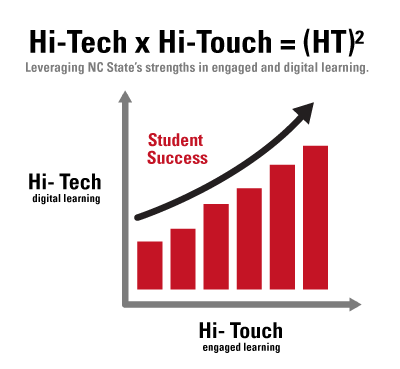Four years ago I participated in a brainstorming session with the deans and other university leaders. The objective was to come up with big ideas that would align with the Pathway to the Future (our strategic plan) and exemplify NC State’s “Think and Do” campaign. I proposed an idea that resonated well with a couple of the deans at my table, so I worked to flesh it out a bit. I named the idea (HT)2: Hi-Tech x Hi-Touch.
The concept was that at NC State we would leverage our unique strengths in engaged and digital teaching and learning to enhance the educational experience and improve the success of our students. One of the deans at the table, Paul Lunn, dean of the College of Veterinary Medicine, said something to the effect of, “That’s exactly how we’re planning to structure our teaching program.” And that’s exactly what they did.
One of the stories in this year’s annual report is about the development of a “distributive” clinical training model for students in CVM’s Equine Primary Care program. The effort is led by Dr. Katie Sheats, an assistant professor in the program. Dr. Sheats applied for and received a DELTA Blended Learning grant to pioneer this model in which the field becomes the classroom, using technology to track and document students’ mastery of skills and competencies as they work in the “real world” of equine medicine.
In the article, Sheats points out that what veterinarians encounter in the field is often very different than the cases that they see in the teaching hospital: “With the distributive model, we have the ability to be sure that we are teaching students about the types of cases they will see on work day one following graduation.” This is a perfect example of (HT)2, combining “high tech” with “high touch” to improve the learning experience.
The idea of using technology to take the classroom to the field also works in reverse. A team of Biology faculty (Miriam Ferzli, Lisa Paciulli, and Betty Black) worked with DELTA staff on an Exploratory Grant to create an immersive experience for students in BIO 181, bringing the field to the classroom using virtual reality technology to create virtual field trips. Traditional field trips can be a challenge, particularly for large enrollment introductory classes due to factors such as logistics, weather, and cost. Virtual reality, done well, can provide an amazingly effective “high touch” learning experience that might not otherwise be possible in such classes.
Another very cool example of (HT)2 is the Global Training Initiative’s collaboration with DELTA to use virtual reality for teaching cultural competencies. I was amazed when I donned a VR headset and found myself immersed in a business meeting with representatives from different countries. I was able to literally (well, virtually) become any one of the individuals in the meeting and experience their thoughts and reactions to words and body language of others in the meeting. This is a great example of how digital technologies can take engaged learning to a whole new level.
There are other examples in the report that exemplify the concept of (HT)2, such as redesigning CE 332 to improve the laboratory experience, and building interactive tools to help students understand how the GI tracts of cats and dogs absorb nutrition in ANS 590.
I hope you will take the time to read these and other stories in our annual report. Much has happened this year, including the rollout of a brand new Online and Distance Education website, improvements in some of DELTA’s core teaching and learning tools such as WolfWare and My Mediasite, our use of social media, and new outreach efforts with Wolfware Outreach and the REPORTER project.
And I hope you will think about your own ideas for (HT)2 and how we might further leverage NC State’s rich tradition of engaged learning with our expertise in digital technologies for teaching and learning. Maybe your course is next!
Sincerely,
Dr. Tom Miller
Vice Provost, DELTA
Senior Vice Provost, Academic Outreach and Entrepreneurship

